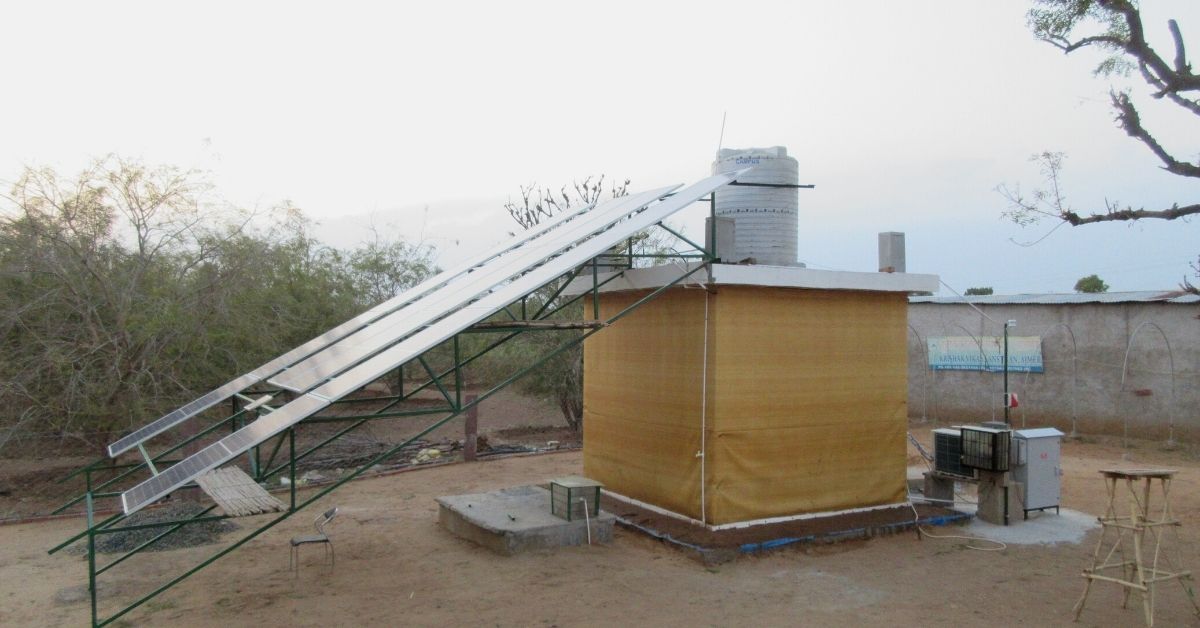Tanwar Singh from Picholiya village in Rajasthan grew a variety of flowers to sell during the festival of Diwali in 2020. He harvested the produce from his 6-acre land four days before the festival – but did not take it to the market. Instead, he waited until a day before the festival.
“I knew that the rates of flowers per crate would be higher at the peak of the festival. Hence, I stored them and still sold them fresh at a higher price of Rs 40 per crate,” Tanwar says. He also saved on transport costs, as he made a single trip to sell all the produce.
As we all know, flowers are highly perishable and difficult to store at room temperatures in any place, let alone Rajasthan.
“The task would have been impossible in the hot and humid weather of Rajasthan. The only alternative I practised over the years was to sell the harvest for four consecutive days before the festival and accept low prices,” Tanwar says.
Tanwar could only pull off the feat because he had access to an innovative low-cost cold storage – the ‘Pusa-Farm SunFridge’ (Pusa-FSF).
Innovation at 1/10th the cost

The innovative technology was conceived by Sangeeta Chopra, a principal scientist at the Indian Agricultural Research Institute (IARI). Since 2016, the researcher, along with a team of scientists at Michigan State University (MSU), USA has been working to conceive the cold storage unit.
The gridless, battery-less, stand-alone, solar-refrigerated cold structure is a joint effort with other scientists from ICAR-IARI and Dr Randolph Beaudry and Dr Norbert Mueller from MSU. The project received funding & from the National Academies of Sciences, Engineering and Medicine, USAID.
The product has no concrete structure, and is established with prefabricated, easy-to-install items. The facility operates an air-conditioning system powered by solar power and uses a unique cooling pipe technique to maintain the temperatures at night.
Moreover, the facility costs around Rs 5 lakh and can store 2,000 kgs of farm produce. The setup cost is drastically cheaper as a full-fledged facility usually costs about Rs 40 lakh.
“The 10×10 structure is made from mesh and fabric that allows air to pass through it in a specific amount. The roof has retro sheets to cover them,” Sangeeta adds, speaking to The Better India.
Sangeeta says that she has always been passionate about solving farmer issues. “I thought of creating an evaporative cooling mechanism for farmers which works on the same principle as a clay pot. The clay pot uses an evaporative cooling technique to cool the water inside,” she adds.

Sangeeta says that her main obstacle to conceiving the facility came when she realised that some refrigeration would still be required during her studies at Michigan State University.
“I wanted to create a structure that would operate without grid electricity. But using the cooling mechanisms of refrigeration would require electricity. Hence, the introduction of solar power,” she adds.
Explaining its features, Sangeeta says, “The innovative design includes a split evaporator coil in the inverter-solar refrigerator unit and a water battery for night time cooling. The refrigeration facility has sensors to adjust the temperature of the air conditioner according to available sunlight. Hence, during low sunlight the air conditioner would not stop functioning and continue to operate with low performance. It would ensure the system is functioning at all times.”
“The structure uses 14 solar panels of 350 Watt each, in a series-parallel circuit, to operate 1.5 tons refrigeration capacity.” she says.
She adds that the structure has low-cost styrofoam panels insulation with mesh and wetted-fabric walls. The pipes installed help to circulate water around the facility. The overall arrangement helps to establish a temperature as low as 2 to 3 degrees Celsius through the combined effects of evaporative cooling and solar refrigeration.
“During the evening hours when the solar panels stop generating electricity, the coils with cold water act as an insulator and help maintain the temperature below 10 degrees Celsius through the night,” she says.
Adding, Sangeeta says that the water system functions like an inverter battery to maintain cold temperatures without electricity. The feature helps avoid the use of an inverter that adds costs to the system.
Potential to help millions of farmers

The scientist says that substantial research and effort went to identify the fabric that suited the structure and deliver the required outcome. The materials used help reduce the overall cost of the facility and other systems.
Apart from Rajasthan, one mini cold storage is installed in Chamrara in Panipat of Haryana and two others in Delhi. The cold storage facilities have benefitted dozens of farmers already.
Tilok Devasi, another farmer from Picholiya, says that during the COVID-19 lockdown, he stored around 13,000 eggs for over two months. “The eggs don’t last over a fortnight, but the facility helped me skip heavy losses during the crisis. I also stored 800 kilos of tomatoes in April.”
“The facility helped me get better control over the market and fetch a good rate,” he adds. Other farmers have been storing coriander, fruits, vegetables, potatoes and other processed food items.
Tanwar says that he plans to experiment with a tomato sauce and purée factory. “I can store a large number of tomatoes and process them. Processing farm produce increases the value and the income. If I succeed, it would be a strength and help economically,” he adds.
Sangeeta says that if the cold storages get installed for farmer groups across India, it could benefit millions of small farmers.
“India loses billions of rupees due to loss of commodities. India needs a strong and reliable chain of cold storages. We have collaborated with one company, and there are talks in progress with the other three. Hope the community at large benefits from the innovation,” she adds.
The scientists also plan to develop a remote-controlled system that farmers can operate the facility sitting at home.
(Edited by Vinayak Hegde)
No comments:
Post a Comment